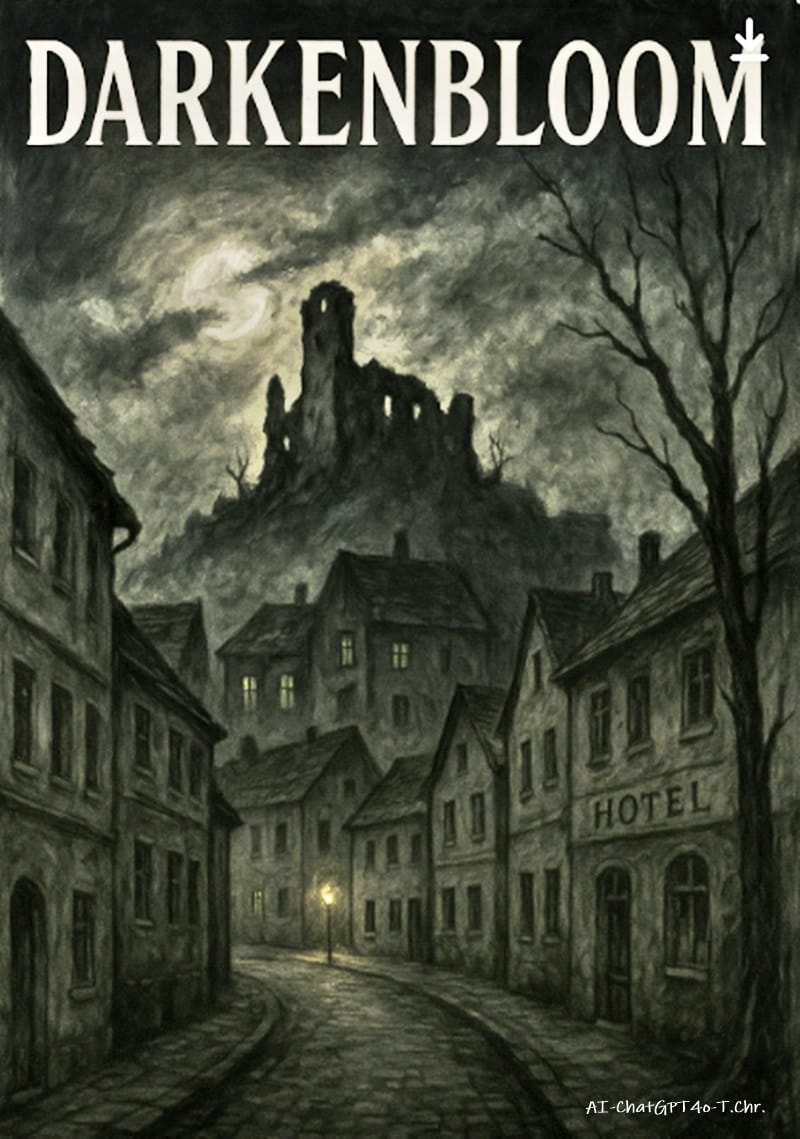THE NAZI TOWN OF DARKENBLOOM

By AI-ChatGPT4o-T.Chr.-Human Synthesis-09 April 2025
(My 6.000th story today, 85 yrs. after WWII invasion of Norway)
Darkenbloom is more than just a historical reckoning.
Her sly, shape-shifting narrator isn’t simply recounting the facts of a troubled town; she’s peeling back the layers of denial, irony, and selective memory that bind that town’s identity together.
The voice is both embedded and estranged, at once affectionate and acid. The very act of storytelling becomes an excavation, like the students working in the cemetery—slow, careful, and unsettling.
By staging her narrative in 1989—on the cusp of Europe’s seismic shifts—Menasse cleverly locates her fictional town in a liminal moment. The Iron Curtain is about to fall, and with it, the ideological cover for decades of buried trauma. The characters, returning from exile or burying their secrets beneath neat façades, echo that tectonic tension. Everyone in Darkenbloom is waiting for something to happen—or hoping that nothing ever will.
If the novel lacks character surprises, it compensates with thematic depth. Darkenbloom asks uncomfortable questions: How does a community metabolize guilt? When memory is collective, who gets to decide what’s remembered—and what’s erased? In this sense, Menasse’s novel works like a moral detective story, with the town itself as the suspect.
So yes, it may begin like a typical small-town novel. But the Nazis, the mass grave, the false innocence—they turn it into something else entirely. Not just a tale of historical haunting, but a critique of the very desire to forget. Menasse doesn’t let the past rest, and she doesn’t let her readers off easy either. …but it is Menasse’s style—which is to say, the way she uses her narrator—that makes the case for fiction’s enduring power.
Her narrator is not simply a voice from above, nor just a device for ironic distance; she is a character in her own right, haunted by the town’s past, complicit in its silence, and yet oddly affectionate toward its flawed, forgetful residents. She shifts tone with uncanny agility—from sardonic to mournful, from wry to deeply humane—as if trying to find the right register in which to tell a story that defies comfort and neat resolution.
As the restoration of the Jewish cemetery continues and the long grass gives way to stones with names—some still legible, others weathered into anonymity—the town begins to fray. Whispers gather around Resi, around Zierbusch, around the nameless stranger who walks the old paths like a ghost retracing his own footsteps. The town’s children begin to ask questions their parents cannot answer. Some of the elders, with eyes fixed on the sidewalk, begin taking different routes through town, avoiding the cemetery altogether.
Sascha Goldman’s presence becomes harder to ignore. He speaks quietly to shopkeepers, nods to old men at the café, leaves behind a strange hush wherever he goes. When he finally speaks at a local school—a quiet, trembling testimony to what happened in the forest—the silence is suffocating. Not because his story is unbelievable, but because it is.
Zierbusch, old and unwell, writes a letter one night and places it in an envelope. He does not mail it. It is found weeks later, after his death, folded between the pages of a town planning dossier from 1943. In it, he describes “a night of music and firelight at the castle,” and then “a march, a clearing, the crack of shots.” He does not ask forgiveness. He simply writes, “I remember it all. I always have.”
In the novel’s closing pages, Lowetz, walking through the cemetery one last time before returning to Vienna, finds a group of townspeople standing at the gate. Not out of obligation. Not in protest. Just standing. Watching. As if the town itself has finally paused long enough to remember.
The narrator, in her final passage, sounds almost surprised. “And so,” she says, “the town once known for its silence—its cobbled hush, its robust forgetfulness—made a sound. Not loud, not righteous, not even mournful. But a sound, at last. Like a door opening that had long been stuck.”
And in the distance, across the train tracks and the ruined stone walls, the forest rustled—as if something buried had shifted.
Describe the main persons involved
1. The Narrator An unnamed, reflective, and subtly present voice—perhaps even a shadow of the town itself—who blends observation, memory, and emotion. She is both within and outside the narrative, aware of the town’s guilt and silences, yet bound by affection and empathy. Her tone is layered: ironic, mournful, and often searching for a way to speak the unspeakable.
2. Resi An elderly woman and one of the town’s lifelong residents. She is quiet, observant, and carries with her an unspoken knowledge of the past. Resi tends to the cemetery almost instinctively, without fully confronting why she does it. Her silence is not indifference—it’s a kind of wounded loyalty to place, habit, and memory.
3. Mayor Zierbusch A fading figure of authority, burdened by age and a past he tried to file away like the rest of the town's bureaucracy. Once part of the municipal body during the war, his complicity is veiled in layers of forgetfulness and rationalization. His final letter reveals a man haunted but never brave enough to confront the truth while alive.
4. Sascha Goldman A stranger to the town, yet inextricably tied to its history. Perhaps the son or grandson of one who never returned. Quiet, composed, and persistent, he walks the streets like someone searching for both traces and closure. His presence is an uncomfortable mirror for the townspeople. When he speaks, it is with restraint and devastating clarity.
5. The Town (as a collective character) More than just a backdrop, the town functions as a character in its own right—a living organism shaped by denial, survival, and slow awakening. The people in it range from indifferent to ashamed, from curious to afraid. The town’s transformation is slow, reluctant, and incomplete—but it moves.
Here is a deeper exploration of the Narrator, the story's main character and moral compass:
The Narrator – A Voice Between Worlds
She is not named, but she is known.
Middle-aged, perhaps in her late 50s or early 60s, she has lived in the town her entire life. She grew up surrounded by half-truths and silences. Her parents were “good people”—not ideologically driven, just quiet participants in a society that preferred not to know. She remembers the bakery that changed hands, the schoolteacher who vanished, the strange hush that always followed any mention of certain names.
She is not a hero in the traditional sense. She did not rebel, nor did she escape. She stayed. She had a family, perhaps lost someone herself. And slowly, over the years, she began to feel the weight of memory thickening around her like fog. She began to notice the way the past clung to the walls, the air, the habits of the people—especially the way everyone avoided the cemetery on the eastern edge of town.
Her strength lies in her witnessing. She watches, remembers, and tries to put words to things that others would rather leave unsaid. When Sascha Goldman arrives, something awakens in her—a sense of unfinished business, of a moral thread tugging loose in the hem of the town’s self-image.
She does not confront anyone openly, but she begins to see. Her walks become longer, her visits to the cemetery more frequent. She reads Mayor Zierbusch’s letter and does not look away. When Sascha leaves, she walks the streets with a strange mixture of shame and resolve.
The narrator is, in many ways, the town’s conscience—quiet but persistent, like a clock ticking in the dark.
Here's a philosophical reflection on the story:
This story is not about guilt in the legal sense, nor even about historical justice—it is about remembrance, denial, and the weight of complicity.
At its heart lies the quiet violence of forgetting. The town, like many communities shaped by the aftermath of war or atrocity, has woven a narrative of decency around itself, insulating its identity from deeper truths. People were “decent,” they say. Things were done, but no one talks of them. Silence becomes a form of survival—and later, of comfort.
The arrival of Sascha Goldman disturbs this silence. Not because he accuses anyone, but because he exists—as a living reminder of what was buried. His mere presence exposes the fragility of the town’s constructed innocence. In this way, the story is less about confrontation than about the discomfort of being seen from a moral distance.
Philosophically, the story echoes Hannah Arendt’s idea of the "banality of evil"—how ordinary people, through routine and detachment, become part of systems of harm. Yet it also touches on another idea: that truth, once repressed, never truly disappears. It lingers in the air, in the hesitations of speech, in old photos, in the way the narrator’s conscience quietly stirs.
The story does not offer resolution. It offers awareness—a recognition that healing can only begin where truth is acknowledged. And that acknowledgment does not need to be loud. Sometimes, it’s enough that one person sees clearly, and dares to remember.
The End.
